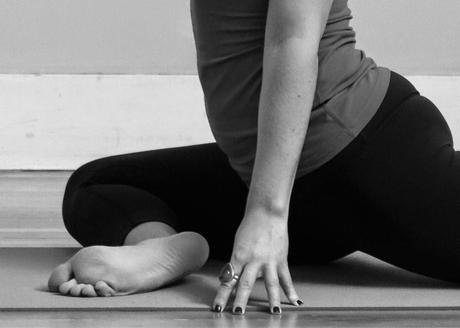Q: I'm wondering if you would please weigh in on something in one of your posts. It has to do with the position of the ankle - dorsiflexion or plantar flexion - in pigeon pose. I've always heard to dorsiflex the ankle (toes toward knee) in thread the needle and pigeon. But recently I heard that in pigeon the ankle should be in dorsiflexion only if the shin is parallel to the front edge of the mat, i.e., at a 90 angle to the knee, as it is in thread the needle, and plantar flexed (pointed, Barbie style) if the knee is bent more than 90, with the foot closer to the hip rather than the top edge of the mat.
Do you guys have an opinion on this? I'd appreciate any insights you can offer.

Pigeon Pose Preparation with Flexed Foot
(I'd have her turn her foot onto its pinky edge so it's in a more neutral position.)
A: Great question, and like most things dealing with yoga poses and alignment issues, it depends! Remember, each person’s body is a bit different from the next, so individual variation is very important in deciding how to do poses. I don’t have a hard and fast rule about the front leg foot in One-Legged Pigeon pose (Ekapada Rajakapotasana 1) or Pigeon preparation (the hip stretch), but I do have one regarding the front knee in these poses. Due to the shape of the pose and the weight and force that gets placed on the front leg, especially in the forward folding version of Pigeon preparation, the pose should never create pain in your front knee joint. The front knee joint is particularly vulnerable to strain or injury in many practitioners with stiff and inflexible hip joints, which is a lot of people! When your hips are stiff and can’t move much, your knee ends up taking the extra forces and can get tweaked and injured. Because most practitioners do have some hip tightness, I typically recommend having the front knee and shin bend towards the opposite hip, so the angle between the thigh and the shin is about 45 degrees of flexion at the knee. At that angle the shinbone rolls towards the floor a bit (external rotation, for my anatomy geeks out there), which can then present a challenge to the next joint downstream, the ankle joint. When the ankle joint is dorsiflexed to 90 degrees here, it can lead to excessive supination or rolling in of the ankle joint—not so good for the ligaments of the outer ankle area. So, I find that for many practitioners, pointing the foot and ankle, known as plantar flexion, feels better and is safer for the ankle, and likely the front knee as well.What about poses such as Reclining Thread the Needle and Pigeon preparation where the front shinbone is parallel with the short front edge of the mat? First off, almost everyone can do Thread the Needle safely, and when you dorsiflex the ankle of your top leg, notice if the knee joint feels better and more stable then when it relaxed or pointed. If it does feel better, then do that. If not, don’t! For the small percentage of practitioners who have enough flexibility in the front hip joint to do Pigeon preparation safely with the front shin bone parallel to the front short edge of the mat, you can try flexing the foot/ankle to 90 degrees with the shinbones and notice the effect on your knee joint: does it feel better and more stable or not? Let that be your guide as to the effectiveness of pointing or flexing the ankle in these poses. Also, notice how it feels when your torso is more upright versus when you forward fold your torso over your front leg. The theory on the benefit of dorsiflexing your front ankle to 90 degrees (as in our photo) is that may bring the knee joint into a more neutral alignment that is safer for all the soft tissue structures of the knee, such as the menisci, ligaments and tendons. But, again, remember that IT DEPENDS on the individual to see if this is true for their body or not. Good luck exploring Pigeon pose!—BaxterSubscribe to YOGA FOR HEALTHY AGING by Email ° Follow Yoga for Healthy Aging on Facebook

